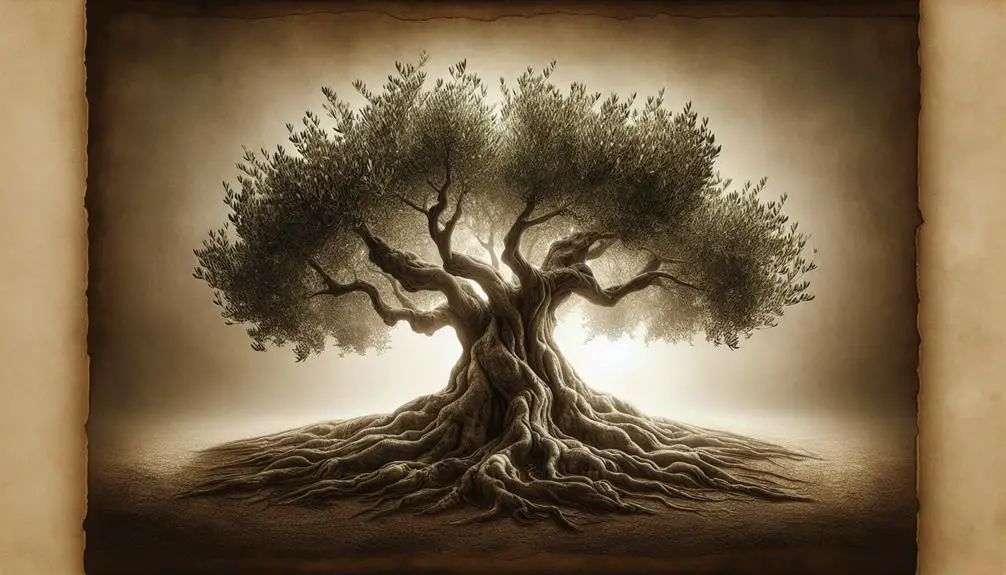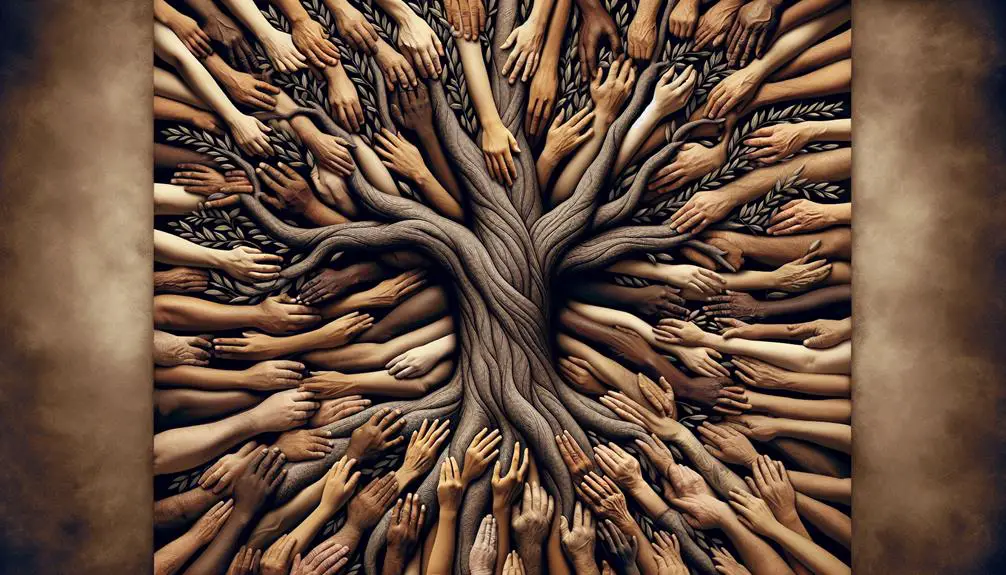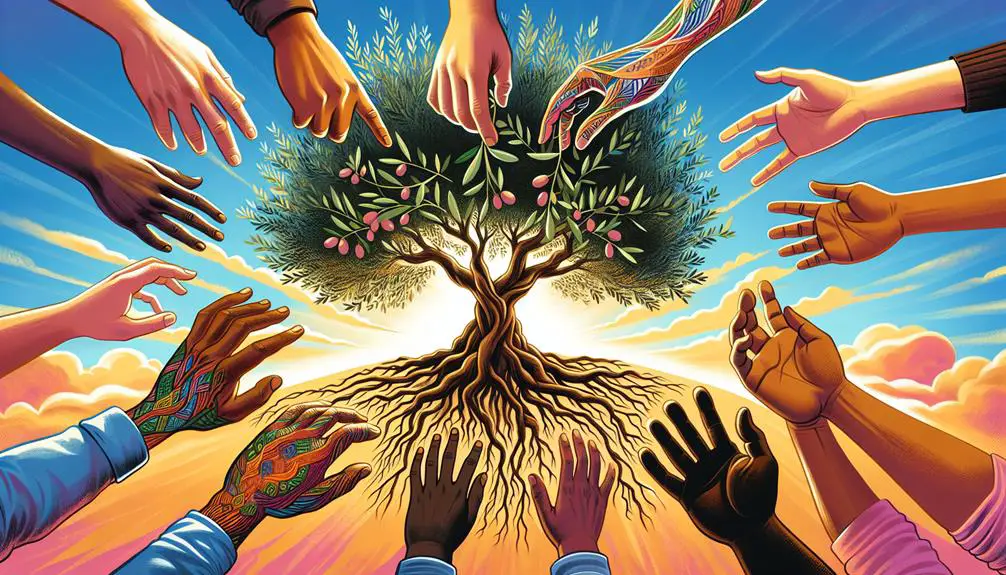Curious about how 'grafted' in the Bible symbolizes unity among believers? Dive into this deep-rooted metaphor's meaning and its call for inclusivity.

Grafted in the Bible
Did you know that the concept of being 'grafted' appears prominently in the New Testament, specifically in Paul's letter to the Romans? This intriguing metaphor captures the essence of spiritual inclusion and the breaking down of barriers between Jews and Gentiles.
As you explore this theme, you'll discover its deep roots in biblical theology and its implications for unity among believers. The metaphor of the olive tree, in particular, offers profound insights into how individuals from diverse backgrounds are integrated into a single, flourishing community.
Let's unpack the rich symbolism and transformative message this notion holds for us today.
Key Takeaways
- Grafting symbolizes spiritual inclusion, merging diverse believers into a unified community.
- The Olive Tree metaphor reflects spiritual renewal and the enrichment of faith.
- Paul's teachings advocate for salvation through faith, extending to both Jews and Gentiles.
- Embracing diversity and fostering unity are essential for spiritual growth and communal harmony.
The Origin of Grafting

Delving into the origins of grafting reveals a centuries-old agricultural practice that has significantly influenced both ancient and modern horticulture. As you explore agricultural history, you'll find that grafting, one of the most fascinating botanical techniques, has played a pivotal role in the development of plant cultivation and biodiversity. This method, essentially a surgical union of two plants, allows for the propagation of desirable characteristics, such as disease resistance or improved fruit quality, ensuring the survival and enhancement of various plant species.
The analytical dissection into the history of grafting shows its roots deeply embedded in ancient civilizations. Historians and botanists alike have traced the practice back to China and the Middle East, where the earliest practitioners recognized its potential and began to refine the technique. These agricultural pioneers laid the groundwork for what would become a cornerstone in the field of horticulture.
Understanding the significance of grafting within agricultural history requires an appreciation for its impact on food security and biodiversity. By enabling the mass production of robust and high-yielding plants, grafting has contributed to the stabilization of food supplies in various cultures throughout history. Moreover, it has facilitated the exchange of botanical knowledge and genetic material across continents, enriching global agriculture.
In the context of botanical techniques, grafting stands out for its ability to combine the traits of different plants into a single, more vigorous specimen. This hasn't only enhanced the aesthetic and nutritional value of fruits and vegetables but also contributed to the resilience of crops against environmental stresses. As such, the origin of grafting represents a key chapter in the story of human interaction with the natural world, showcasing innovation and adaptability in the face of agricultural challenges.
Symbolism in Scripture

The Bible's rich tapestry of narratives and teachings is imbued with symbolism that serves to deepen readers' understanding of spiritual truths and divine principles. This use of symbolic language and imagery isn't merely for artistic effect; it's a deliberate choice to convey complex ideas and teachings in a manner that's accessible and resonant. Throughout scripture, you'll encounter mystic allegories and parable interpretations that challenge you to look beyond the literal to grasp the essence of the divine message.
To grasp the depth of symbolism in scripture, consider these key aspects:
- Water as a symbol of purification and life: Throughout the Bible, water is used to represent cleansing, rebirth, and the sustenance of life, inviting you to reflect on your spiritual cleansing and growth.
- Light as a metaphor for truth and divine presence: Light dispels darkness and is often used to symbolize the revelation of truth and the presence of God, encouraging you to seek enlightenment and divine guidance.
- Bread as a representation of sustenance and communion: In many passages, bread signifies the nourishment of the soul and the community of faith, urging you to consider what truly sustains you spiritually.
- The vineyard as an allegory for spiritual cultivation: The imagery of the vineyard reflects themes of growth, pruning, and harvest, symbolizing the process of spiritual development and the fruits of faith.
Paul's Teaching in Romans

Paul's letter to the Romans offers a profound exploration of faith, salvation, and the role of God's law, inviting you to consider the foundational principles of Christian belief. As you delve into this epistle, you encounter Paul's teachings on justification by faith and the juxtaposition of law versus grace, central themes that challenge and enrich your understanding of Christian doctrine.
Theme |
Description |
Implication |
|---|---|---|
Justification by Faith |
Paul argues that faith in Jesus Christ, rather than adherence to the law, justifies a person before God. |
This shifts the focus from works to faith as the basis for righteousness. |
Law versus Grace |
Paul contrasts the law, which reveals sin and condemns, with grace, which forgives and brings life. |
Highlights the transformative power of grace over the law's limitations. |
Salvation for All |
Paul emphasizes that salvation is available to both Jews and Gentiles, uniting them in Christ. |
Underlines the inclusivity and universality of the gospel. |
Paul's discourse in Romans meticulously unfolds the dynamics of salvation, challenging you to reflect on the role of the law and the liberating power of grace. He articulates that the law, while holy and good, ultimately serves to reveal humanity's sinfulness and need for a savior. Grace, on the other hand, offered through faith in Jesus Christ, accomplishes what the law could not: justification and reconciliation with God.
Through this scholarly and analytical lens, you're encouraged to appreciate the depth of Paul's theological insights. His teachings in Romans not only provide a foundation for Christian belief but also invite a reevaluation of how faith and grace intersect with daily living, steering clear from the legalism that can ensnare believers.
Unity Among Believers

You must consider how fostering spiritual togetherness serves as a cornerstone for unity among believers within biblical contexts.
Embracing diverse beliefs highlights the scriptural encouragement for inclusivity and acceptance amongst the faithful.
Lastly, promoting love and peace is crucial, as these values are repeatedly emphasized as the foundation of communal harmony in scriptural teachings.
Fostering Spiritual Togetherness
Fostering spiritual togetherness often necessitates a deliberate effort to bridge doctrinal differences and cultivate a sense of unity among believers. This unity isn't merely a matter of convenience but a profound testament to the power of faith to transcend individual perspectives and backgrounds. Achieving this requires:
- Acknowledgement of diverse cultural backgrounds
- Openness to religious pluralism
- Commitment to mutual respect
- Continuous dialogue and engagement
In this context, cultural integration and religious pluralism aren't just buzzwords but essential frameworks for understanding and appreciating the mosaic of beliefs within a faith community. By embracing these principles, believers can foster a spiritual togetherness that strengthens their collective faith journey, ensuring that doctrinal differences enrich rather than divide their communal experience.
Embracing Diverse Beliefs
Within the tapestry of faith communities, embracing diverse beliefs stands as a pivotal step toward achieving unity among believers. This process, deeply rooted in cultural assimilation and interfaith dialogue, requires an analytical approach to understand its significance.
Cultural assimilation, in this context, doesn't imply the erasure of individual beliefs but rather promotes an environment where varied religious practices and doctrines can coexist harmoniously.
Interfaith dialogue, on the other hand, fosters a platform for open, respectful conversations between different belief systems, aiming to bridge gaps and build mutual understanding.
Together, these mechanisms function as essential tools in navigating the complexities of religious diversity. They not only encourage tolerance and respect among disparate groups but also lay the groundwork for a united, inclusive faith community.
Promoting Love, Peace
Building on the foundation of embracing diverse beliefs, promoting love and peace among believers is crucial for the development of unity within faith communities. To achieve this, you should consider several factors:
- Recognizing and addressing economic disparities that may exist among members
- Respecting and valuing different cultural traditions within the community
- Encouraging open and honest dialogue to foster mutual understanding
- Implementing inclusive practices that welcome and celebrate diversity
The Olive Tree Metaphor

You must consider the rich symbolism of the olive tree within biblical texts, which serves as a powerful metaphor for spiritual inclusion and renewal.
The process of grafting, intricately described, highlights the integration of believers into a singular, cultivated community.
This imagery not only encapsulates the unity among believers but also underlines the transformative growth achieved through faith.
Symbolism of Olive Tree
One often encounters the olive tree in biblical texts, where it serves as a profound metaphor for spiritual growth and the interconnectedness of believers. Olive production, thriving in the Mediterranean climate, symbolizes resilience, prosperity, and peace. This tree's enduring nature and the oil it yields have deep spiritual connotations.
Consider the following points:
- The olive tree represents an enduring source of nourishment and light, essential for spiritual sustenance.
- Its roots in the Mediterranean climate symbolize a strong foundation in faith.
- Olive production signifies the cultivation of spiritual attributes over time.
- The tree's longevity and ability to regenerate symbolize hope and renewal in spiritual life.
Analyzing these aspects helps one appreciate the olive tree's symbolic richness in biblical narratives, underscoring themes of growth, resilience, and community.
Process of Grafting
Having explored the symbolism of the olive tree in biblical texts, we now turn our attention to the process of grafting, a metaphor that further enriches our understanding of spiritual interconnectedness.
Grafting, a horticultural technique, involves joining parts from two plants so they grow as one. This method, steeped in biological implications, symbolizes the merging of distinct entities into a unified whole. Through grafting, a robust exchange of genetic material occurs, resulting in a hybrid vigor that enhances the resilience and productivity of the grafted plant.
This process mirrors spiritual teachings on unity, growth, and renewal. It's a vivid illustration of how disparate elements can come together to form a stronger, more fruitful entity, highlighting the profound interconnectedness of all living things.
Implications for Gentiles

The concept of being 'grafted in,' as described in the Bible, profoundly impacts Gentiles' inclusion within the spiritual legacy of Israel. This metaphorical grafting signifies not just a religious but also a profound socio-cultural integration, bringing to the forefront two critical areas: legal implications and cultural adaptation.
From a legal standpoint, the grafting in of Gentiles implies a transition from outsiders to recipients of the promises and covenants initially given to Israel. This shift necessitates a reevaluation of the legal standing of Gentiles within the faith community, challenging traditional boundaries and calling for a more inclusive interpretation of scriptural laws.
Cultural adaptation, on the other hand, involves the melding and assimilation of Gentile cultures into the rich tapestry of Jewish traditions and practices. This process demands sensitivity and openness from both sides, fostering a community that respects and celebrates diversity while maintaining a shared spiritual heritage.
To further elucidate the implications for Gentiles, consider the following points:
- Legal Status: Gentiles' newfound standing within the spiritual community challenges and expands traditional legal frameworks.
- Cultural Integration: The process encourages a blending of cultures, enriching the community's diversity.
- Spiritual Inheritance: Gentiles gain access to the spiritual legacy and promises once exclusive to Israel.
- Community Dynamics: This inclusion reshapes community dynamics, promoting a more inclusive and unified body of believers.
Understanding these aspects is crucial for comprehending the full scope of what it means for Gentiles to be 'grafted in,' highlighting the transformative power of this concept on individual and communal levels.
Living as Grafted Branches

Many believers find themselves navigating the complex journey of living as grafted branches, a process that demands both personal and communal adaptation to fully embody the spiritual and cultural integration outlined in biblical teachings. This metaphor, rich in agricultural imagery, serves as a foundational concept for understanding one's spiritual lineage and the ongoing nourishment required to sustain faith and communal harmony.
Root identification plays a critical role in this journey. You must recognize and align with the foundational truths and traditions that underpin your faith. This involves a deep dive into scriptural understanding and embracing the heritage of those who walked the path of faith before you. It's not merely about acknowledging historical roots but actively engaging with them, allowing these traditions to inform and shape your daily living and spiritual practice.
Branch nourishment, on the other hand, emphasizes the importance of ongoing spiritual, emotional, and communal support. As a grafted branch, you're called to seek out and contribute to environments that promote growth, learning, and the flourishing of faith. This includes engaging in practices that enrich your connection with the divine, such as prayer, meditation, and study of sacred texts, as well as participating in community life that reflects and reinforces these values.
Living as grafted branches requires a balance of honoring one's roots while actively contributing to the nourishment and health of the larger faith community. It's a dynamic process of growth, adaptation, and deepening, where you're continually challenged to integrate the wisdom of the past with the realities of the present in pursuit of spiritual maturity and communal well-being.
Spiritual Reconciliation and Hope

Exploring spiritual reconciliation and hope invites you to consider the transformative power of forgiveness and renewal within your faith journey. This exploration isn't merely an inward-looking endeavor but extends outward, offering a pathway to personal redemption and a deeper understanding of cultural integration. The biblical imagery of being grafted, as discussed in previous sections, serves as a potent symbol for this process, embodying the potential for unity and growth from disparate origins.
Consider the following aspects when contemplating spiritual reconciliation and hope:
- Personal Redemption: It's a journey of returning to one's spiritual roots, acknowledging past missteps, and embracing the promise of a fresh start. This process is deeply personal yet universally applicable, reflecting the individual and collective yearning for renewal.
- Cultural Integration: It emphasizes the importance of embracing diverse cultural backgrounds within the faith community, recognizing that unity doesn't necessitate uniformity. This integration fosters a richer, more inclusive understanding of spirituality.
- Forgiveness and Renewal: Central to the concept of reconciliation, these elements highlight the ongoing need for grace, both received and extended, in the pursuit of spiritual wholeness.
- Hope as a Catalyst: Hope isn't passive; it propels individuals and communities towards action, underpinning efforts toward reconciliation and the building of a more compassionate, understanding faith community.
In analyzing spiritual reconciliation and hope, it's crucial to recognize the interplay between personal redemption and cultural integration. These elements collectively contribute to a more profound, enriched spiritual experience, encouraging a journey of continual growth, understanding, and unity within the faith community.
Frequently Asked Questions
How Have Different Christian Denominations Interpreted the Concept of Being "Grafted" Into the Faith Differently?
You're looking at how various Christian denominations perceive being 'grafted' into the faith. They diverge mainly around Gentile inclusion and theological implications.
Some view it as an open invitation to non-Jews, emphasizing universal acceptance. Others focus on the theological implications, seeing it as a symbolic adoption into God's family.
This interpretation shapes their understanding of community and belonging, leading to varied practices and beliefs about who's included in their faith community.
Are There Any Historical Records of Early Christian Communities Practicing Physical Rituals to Symbolize the Grafting Process?
You're exploring whether early Christian communities had physical rituals to symbolize grafting ceremonies. While there's no direct evidence of specific grafting ceremonies, the practice of ritual symbolism was prevalent.
Early Christians often used metaphors and symbols to express complex theological ideas. Baptism, for example, might be seen as a form of spiritual grafting, symbolizing new life and inclusion into the community.
Yet, explicit records of ceremonies uniquely for grafting are scarce.
How Does the Concept of Grafting in the Bible Relate to Contemporary Ecological or Agricultural Practices?
You're diving into how grafting relates to eco-friendly practices, minus the biblical roots. It's like asking if trees text each other about water conservation.
Seriously though, grafting mirrors environmental stewardship and sustainable farming by combining species for resilience and productivity. This method enhances biodiversity, promoting healthier ecosystems.
Analyzing this, it's evident that agricultural techniques, like grafting, can teach us a lot about sustainability and caring for our planet.
Can the Grafting Metaphor Be Found in Other Religious Texts Outside of Christianity, and How Is It Interpreted?
Yes, the grafting metaphor appears in other religious texts, symbolizing cultural symbiosis and metaphorical adaptation. It's often used to describe the blending of beliefs or the introduction of new ideas into established traditions.
In these contexts, grafting transcends its agricultural roots, embodying the integration and growth of spiritual concepts. This metaphorical usage underscores the universal human experience of adapting and integrating new elements into existing structures, both religious and cultural.
Has the Metaphor of Grafting Influenced Christian Art or Literature Throughout History, and Can You Provide Examples?
Yes, the concept of grafting has significantly influenced Christian art and literature, inspiring countless artistic interpretations. By weaving grafted imagery into their works, artists and writers have explored themes of unity, growth, and transformation.
For example, medieval illuminated manuscripts often depict grafted branches to symbolize the incorporation of Gentiles into the Christian faith. This metaphor extends into Renaissance paintings and modern Christian literature, serving as a powerful symbol of spiritual connection and renewal.
Conclusion
As you've journeyed through the rich tapestry of biblical grafting, it's clear that this ancient horticultural practice blossoms with profound spiritual symbolism.
Paul's olive tree metaphor in Romans isn't merely a lesson in botany; it's a masterclass in unity and inclusion.
You, as a grafted branch, are called to bear fruit in a diverse orchard of faith.
This divine grafting offers a promise of spiritual reconciliation and hope, weaving a verdant tapestry of interconnectedness that transcends earthly divisions.



Sign up